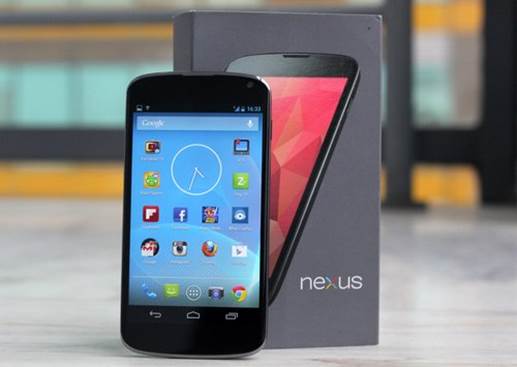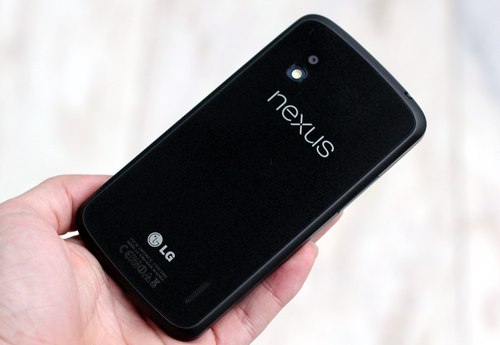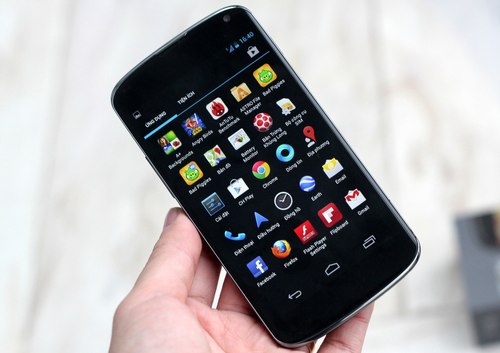Nexus 4 is among top Android smartphones
that are best at price, specs, features and performance, marking the first
corporation between Google and LG.
Design
In the Google Nexus series, Nexus 4 not
only bears similarity with previous models such as Nexus S and Galaxy Nexus
(manufactured by Samsung) but also look quite different since it is the first
product made by LG and Google.

Nexus
4
Nexus 4 shares common specs with LG Optimus
G, yet their appearances are different. The device looks thicker and smoother
with 4 rounded corners with a shiny metal lining surrounding the edge. Like
Galaxy Nexus, Nexus 4’s front has no button, even touch-sensitive one; instead
buttons are buried below the screen.
The front is symmetrically and flat
designed, not curved like Galaxy Nexus. The bezels are sleek and striking
features, making the screen look larger. However, this sometimes obstructs the
palm when handling. Besides, when the screen’s off, it’s hard to differentiate
between the device’s head and tail.
With 9.1mm thickness, Nexus 4 is not a
sleek smartphone and this can be felt easily in palm. The solid-state design with
the 139g weight gives LG’s smartphone the sturdiest and most reliable handle
among 3 previous Nexus models. But with the obstructed feeling and heaviness,
holding the device for long may be quite exhausting.

Retaining
Google Nexus’s inspiration, LG Nexus 4 still has its own beauty.
The back incorporates a glass layer instead
of a polycarbonate coat like in most existing smartphones. Compared with
Optimus G, Nexus 4’s case is interesting and nice with concave 3D patterns. All
info about the machine is also printed on the product’s back.
While logos (Nexus or LG), internal
speakers and LED flash are specifically and carefully designed, the 8MP camera looks
quite simple, not deserving such hi-end smartphone.
The surround linings are made of rough
plastic, keeping the device firm in hand and preventing it from slipping. Volume
keys on the right and power button on the left are well designed plus easy-to-press.
On top lies 3.5mm jack slot while micro-USB port is in the bottom where there’re
also only two screws of the device.
Nexus 4’s solid state design has a
drawback: no support for external memory card. To replace the battery, user has
to open the case, though the action is not too difficult. The product supports
micro-SIM and the tray is situated right below volume keys on the left.
Display
Nexus 4 owns a 4.7in display featuring LCD
True IPS+ technology from LG, instead of AMOLED from the previous Nexus S and
Galaxy Nexus. LG’s screen features 1,280x768pixel resolution, slightly higher
than HD 720p standard. Compared to Galaxy Nexus, Nexus 4’s colors have higher
vividness and accuracy.
The 4.7in delivers 608nit brightness, with
320ppi pixel density, such high level for user’s eyes to see onscreen details
sharp and smooth. Though having larger screen than Galaxy Nexus, using RGB
pixel formats helps the True HD IPS+ screen on Nexus 4 display sharper and
smoother details than Super AMOLED on Galaxy Nexus plus there’s fewer noise.

The
True HD IPS+ screen delivers good image quality.
Beside accuracy and sharpness, LG also use
Zerogap panel (similar to In-cell), helping to combine the display and
sensitive panels in order to make the screen sleeker. Thus, Nexus 4 looks more
prominent and closer to the glass screen. The Korean brand also equipped the
model with Gorilla Glass 2 surface with high toughness. In test, when dropped,
Nexus 4’s front was still intact while the back was partly broken.
True HD IPS+ technology gives LG screen impressive
depth; in some cases, user easily mistook the screen’s dark areas for the
front’s black surface. But compared to Super AMOLED screen of Galaxy S III,
Nexus 4 showed low contrast and its outdoor display couldn’t rival. At
auto-brightness Nexus 4 felt fairly dark, in comparison with other models. Another
test showed that Nexus 4’s touchscreen could detect 10 fingers at the same time.
Features
Nexus 4 owns all apps developed by Google.
This is also the purest Android smartphone with Android’s default UI. Nexus 4’s
strength is keeping fullest of Android features and receiving latest updates
while other hi-end smartphones have to wait for months to get.
On previous Nexus models, Android user
often feels disadvantageous in comparison with Samsung Galaxies, HTC One Series
or Sony Xperia models… Nexus 4 is a different story; equipment from Google for
Android 4.2 is competitive, even better than that from many hi-end Androids
such as S III, One X+… thanks to a newer version of the OS.

Nexus
4 is well equipped.
Nexus 4’s new interesting features are lock
screen with various Home pages, improved Google Now, visual Notification Bar
supporting quick toggle for modes. Besides, user will enjoy the wireless
Miracast protocol, nice-looking Day Dream screensaver in the latest Android 4.2
Jelly Bean.
The product supports wireless charging and
NFC. Music/video player is installed by default, with Equalizer. Nexus 4
doesn’t only aim at Android-custom users or Google software developers like
earlier Nexus models did. It now becomes a smartphone that well serves common
uses, from entertainment to work.